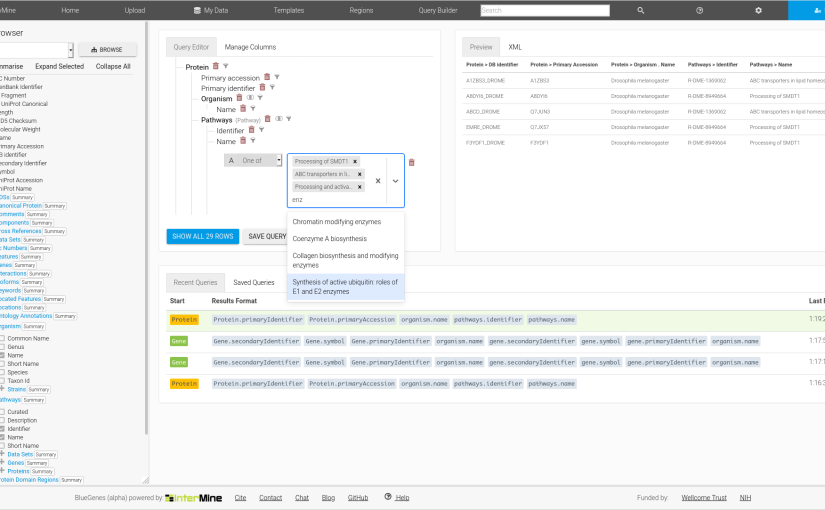We are super excited to announce that BlueGenes 1.0.0 has been officially released!
BlueGenes is a new user interface to InterMine utilising its extensive web services combined with a modern web application stack, to provide a more interactive experience for exploring and analysing your data. In contrast with the previous interface, BlueGenes is separate from the InterMine server, increasing the ease of further development to both.
The new interface provides the same feature set you’re already familiar with, wrapped in a new design offering an enhanced user experience. In addition, it allows you to quickly change the InterMine server you’re connected to, to any other instance in your organisation or that is available through the InterMine Registry. While the old webapp acted as a front-end to a single InterMine, BlueGenes can be configured to serve multiple InterMine servers.
A new Tool API for adding custom visualisations and analyses tools to your InterMine has also been introduced. This allows you to create your own tiny JavaScript apps (or adapt the ones we have developed for HumanMine and FlyMine) for your InterMine data, which BlueGenes will display for list analysis, query results and/or report pages, depending on what you specify it supports.
While this is the first major release, we still have lots more coming. Some admin tasks, notably creating templates, is not available in BlueGenes yet so you will have to access the legacy webapp for this. The web services have yet to be separated from the legacy webapp, so it will continue to be available for a while (if you wish to wait with switching to BlueGenes, we recommend using the latest InterMine 4.x release instead).
This new release requires InterMine 5.0.0. To upgrade to InterMine 5.0.0 please read the upgrade instructions carefully.
InterMine 5.0.0 release
This releases contains new web services to support BlueGenes’s new features, in particular:
- Login using OAuth2 (e.g. Google, Elixir)
- Upgrading lists
- Generate external links
- Submit feedback
- Reset password
This release includes the Frictionless Data Package specifications implemented by Nikhil Vats. Please see the documentation here for more details.
All the InterMine artifacts have been published on the Maven Central repo instead of Bintray’s JCenter due to the recent jcenter/bintray shutdown announcement.
For more details about this release, please see the release notes.
Documentation
The user documentation has been adapted to the new interface by Hanan (Outreachy intern) and is available here.
The InterMine Server documentation (aka dev documentation) has been revised by Mardhiyah (Outreachy intern) and is available here.
FlyMine and HumanMine
FlyMine has been updated to use BlueGenes. If you use Firefox, you might experience an issue due to the browser cache, in that case you need to delete the cache. The legacy user interfaces is still available here.
HumanMine will be updated soon.
Thanks to …
… all our users/contributors for their support, feedback and help. Thanks to Joshua Heimbach and Yo Yehudi for their great and essential past contributions to this project. Thanks to our excellent interns who have directly contributed to BlueGenes; Akshat for the 2019 GSoC project Javascript Data Visualisations, Sakshi Srivastava for the 2020 Outreachy mid-year project Javascript Data Visualisations, Roshni Prajapati for the 2020 Outreachy mid-year project Improve UI & UX of BlueGenes, and Hanan Younes for the 2020 Outreachy end of year project Create InterMine user training docs.
Contact us
If you have any questions or concerns about any of these changes, please do not hesitate to contact us.

You must be logged in to post a comment.